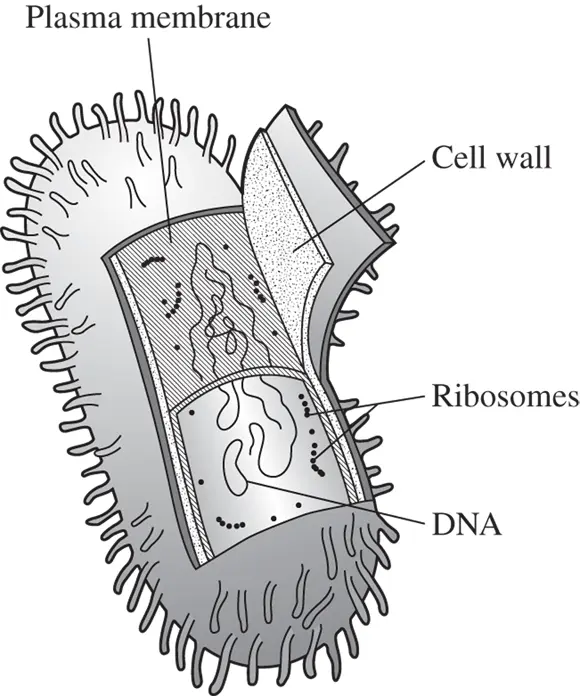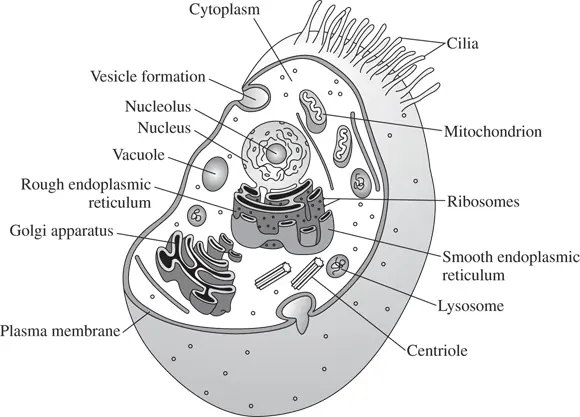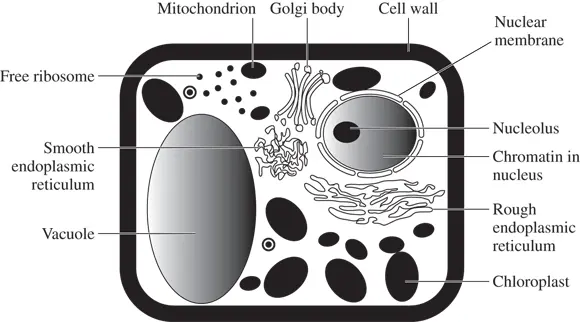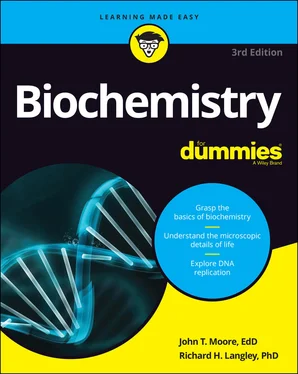Prokaryotes are mostly bacteria. Besides the lack of a nucleus, a prokaryotic cell has few well-defined structures. The prison cell’s structure has three components: a cell wall, an outer membrane, and a plasma membrane. This structure allows a controlled passage of material into and out of the cell. The materials necessary for proper functioning of the cell float about inside it, in a soup known as the cytoplasm. Figure 1-1 depicts a simplified version of a prokaryotic cell.

FIGURE 1-1:Simplified prokaryotic cell.
Eukaryotes are animals, plants, fungi, and protists (any organism that isn’t a plant, animal, or fungus). Many are unicellular organisms, like most algae, while other types of algae are multicellular. You consist mostly of eukaryote cells. In addition to having a nucleus, eukaryotic cells have a number of membrane-enclosed components known as organelles. Eukaryotic organisms may be either unicellular or multicellular. In general, eukaryotic cells contain much more genetic material than prokaryotic cells.
Animal Cells and How They Work
All animal cells (which, as the preceding section explains, are eukaryotic cells) have a number of components, most of which are considered to be organelles. These components, and a few others, are also present in plant cells (see the section “ A Brief Look at Plant Cells,” later in this chapter). Figure 1-2 illustrates a simplified animal cell.

FIGURE 1-2:Simplified illustration of an animal cell.
The primary components of animal cells include
Plasma membrane: This structure separates the material inside the cell from everything outside the cell. The plasma or cytoplasm is the fluid inside the cell. For the sake of the cell’s health, this fluid shouldn’t leak out. However, necessary materials must be able to enter through the membrane, and other materials, including waste, must be able to exit through the membrane. (Imagine what a cesspool that cell would become if the waste products couldn’t get out!) Transport through the membrane may be active or passive. Active transport requires that a price be paid for a ticket to enter (or leave) the cell. The cost of the ticket is energy. Passive transport doesn’t require a ticket. Passive transport methods include diffusion, osmosis, and filtration.
Centrioles: These structures behave as the cell’s train conductors. They organize structural components of the cell like microtubules, which help move the cell’s parts during cell division.
Endoplasmic reticulum: The cell can be thought of as a smoothly running factory. The endoplasmic reticulum is the main part of the cell factory. This structure has two basic regions, known as the rough endoplasmic reticulum (the factory assembly line for protein production), which contains ribosomes, and the smooth endoplasmic reticulum, which does not. (You can find out more about ribosomes and their function later in this list.) The rough endoplasmic reticulum, through the ribosomes, is the factory’s assembly line. The smooth endoplasmic reticulum is more like the shipping department, which ships the products of the reactions that occur within the cell to the Golgi apparatus.
Golgi apparatus: This structure serves as the cell’s postal system. It looks a bit like a maze, and within it, materials produced by the cell are packaged in vesicles — small, membrane-enclosed sacs. The vesicles are then mailed to other organelles or to the cell membrane for export. The cell membrane contains customs officers (called channels ) that allow secretion of the contents from the cell. Secreted substances are then available for other cells or organs.
Lysosomes: These are the cell’s landfills. They contain digestive enzymes that break down substances that may harm the cell ( Chapter 6has a lot more about enzymes). The products of this digestion may then safely move out of the lysosomes and back into the cell. Lysosomes also digest no-longer functioning (dead) organelles. This slightly disturbing process, called autodigestion, is really part of the cell digesting itself. (We’ve never gotten that hungry!)
Mitochondria: These structures are the cell’s power plants, where the cell produces energy. Mitochondria (singular mitochondrion ) use food, primarily the carbohydrate glucose, to produce energy, which comes mainly from breaking down adenosine triphosphate (or ATP, to which we have dedicated Chapter 13).
Nucleus/nucleolus: Each cell has a nucleus and, inside it, a nucleolus. These two regions serve as the cell’s control center and are the root from which all future generations originate. A double layer known as the nuclear membrane surrounds the nucleus. Usually the nucleus contains a mass of material called chromatin. If the cell is entering a stage leading to reproducing itself through cell division, the chromatin separates into chromosomes. In addition to conveying genetic information to future generations, the nucleus produces two important molecules for the interpretation of this information. These molecules are messenger ribonucleic acid (mRNA) and transfer ribonucleic acid (tRNA). The nucleolus produces a third type of ribonucleic acid known as ribosomal ribonucleic acid (rRNA). ( Chapter 9is all about nucleic acids.)
Ribosomes: These components contain protein and ribonucleic acid subunits. In the ribosomes, amino acids are assembled into proteins. Many of these proteins are enzymes, which are part of nearly every process that occurs in the organism. (Part II of this book is devoted to amino acids, proteins, and enzymes.)
Small vacuoles: Also known as simply vacuoles, these structures serve a variety of functions, including storage and transport of materials. The cell may later use these stored materials, or if the cell no longer needs these materials, they are simply waste.
A Brief Look at Plant Cells
Plant cells contain the same components as animal cells, plus a cell wall, a large vacuole, and, in the case of green plants, chloroplasts. Figure 1-3 illustrates a typical plant cell.
The cell wall is composed of cellulose. Cellulose, like starch, is a polymer of glucose. The cell wall provides structure and rigidity.
The large vacuole serves as a warehouse for large starch molecules. Glucose, which is produced by photosynthesis, is converted to starch, a polymer of glucose. At some later time, this starch is available as an energy source. ( Chapter 7talks a lot more about glucose and other carbohydrates.)

FIGURE 1-3:Simplified illustration of a plant cell.
Chloroplasts, present in green plants, are specialized chemical factories. These are the sites of photosynthesis, in which chlorophyll absorbs sunlight and uses this energy to combine carbon dioxide and water to produce glucose and release oxygen gas.
Читать дальше















